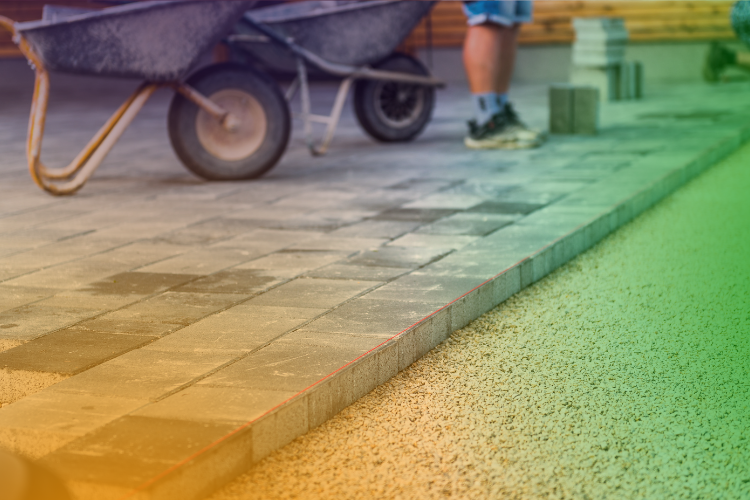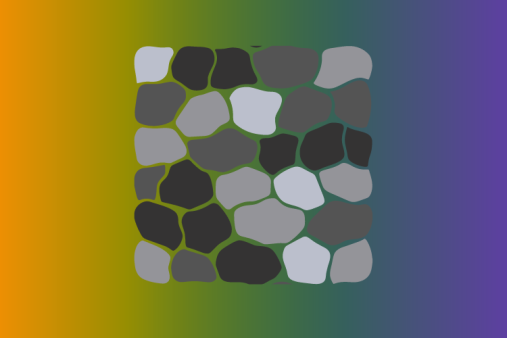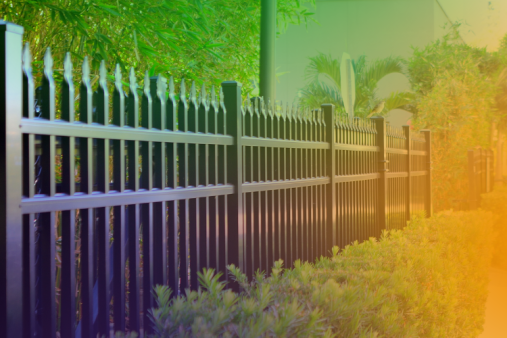Whether you're considering a new driveway installation or looking to maintain and repair your existing one, understanding the terminology can be a daunting task. From asphalt to xeriscaping, the world of driveway construction and maintenance is filled with specific terms that can easily confuse even the most seasoned homeowner.
To help you navigate this complex landscape, we've created an A-Z driveway glossary. This comprehensive guide will provide you with clear, concise descriptions of over 100 essential terms, ensuring you're well-informed for every step of your driveway journey. Dive in and discover the key concepts that will help you achieve a durable and attractive driveway.
A
- Aggregate: Crushed stone, gravel, or other materials used as a base layer or surface for driveways.
- Asphalt: A black, sticky substance used for paving roads and driveways, also known as tarmac.
- Asphalt Overlay: A new layer of asphalt applied over an existing driveway surface.
B
- Base Course: The layer of material laid on top of the subgrade, providing structural support for the driveway.
- Bitumen: A viscous black mixture used as a binder in asphalt for driveways.
- Block Paving: A method of paving using individual bricks or blocks, often made of concrete or clay.
- Brick Driveway: A driveway paved with bricks, known for its aesthetic appeal and durability.
- Broom Finish: A technique used in concrete driveways where a broom is dragged over the surface to create a textured finish.
C
- Cement: A binder used in concrete, crucial for constructing driveways.
- Chip Seal: A driveway surface treatment combining one or more layers of asphalt with one or more layers of fine aggregate.
- Cobblestone: Natural stone used in driveways for a classic, high-end look.
- Cold Patch: A type of asphalt repair material that can be applied without heating.
- Compaction: The process of compressing the driveway base material to ensure stability.
- Concrete: A mixture of cement, aggregate, and water used to create a durable driveway surface.
- Concrete Sealer: A protective coating applied to concrete driveways to prevent staining and water damage.
- Crazing: A network of fine cracks on the surface of concrete driveways.
D
- Decorative Concrete: Concrete with added patterns, colors, or textures to enhance aesthetic appeal.
- Drainage: The system used to remove water from the driveway surface, preventing damage and erosion.
- Driveway Apron: The area where the driveway meets the street or pavement.
- Driveway Edging: The materials used to define the edges of a driveway and provide structural support.
E
- Excavation: The process of removing soil to prepare the site for a driveway installation.
- Exposed Aggregate: A decorative concrete finish where the top layer of cement is washed away to reveal the underlying aggregate.
F
- Flexural Strength: The ability of a driveway material, such as concrete, to resist bending or cracking under load.
- French Drain: A trench filled with gravel and a perforated pipe used to redirect surface water away from the driveway.
- Frost Heave: The uplift of a driveway caused by the expansion of freezing water in the soil beneath.
G
- Geotextile Fabric: A permeable fabric used to separate soil layers and improve drainage in driveway construction.
- Gravel Driveway: A driveway surface made of loose stones or gravel, offering a rustic look.
- Gravel Grid: A stabilization system used in gravel driveways to prevent the gravel from spreading.
H
- Heaving: The upward movement of a driveway surface caused by freeze-thaw cycles or tree roots.
- Hot Mix Asphalt: Asphalt heated to a high temperature and used for paving driveways.
I
- Impermeable Surface: A driveway surface that does not allow water to penetrate, such as concrete or asphalt.
- Imprinted Concrete: Concrete stamped with patterns to resemble stone, brick, or tile.
- Interlocking Pavers: Paving stones designed to fit together without mortar, creating a stable surface for driveways.
J
- Jointing Sand: Sand used to fill the gaps between pavers or bricks in a driveway, helping to lock them in place.
- Joint Sealer: A sealant used to fill and protect joints in concrete driveways from water and debris.
K
- Kerb: The edge of a driveway where it meets the road or pavement, often made from concrete or stone.
- Kiln-Dried Sand: Sand dried in a kiln, used to fill joints in block paving.
L
- Landscaping Fabric: A fabric placed under driveway materials to prevent weed growth and aid in drainage.
- Levelling: The process of making a driveway surface even and smooth.
- Limestone: A sedimentary rock used as aggregate in driveway construction.
M
- Macadam: A type of road or driveway surface made from layers of compacted stone, sometimes bound with tar or bitumen.
- Manhole Cover: A removable cover over a manhole, often incorporated into driveway design.
- Mortar: A mixture of cement, sand, and water used to bond bricks or stones in driveway construction.
N
- Non-Slip Finish: A textured driveway surface designed to provide traction and prevent slipping.
O
- Oil Stain: A common type of stain on driveways caused by leaking vehicles.
- Overlay: Adding a new layer of material over an existing driveway surface to improve appearance and durability.
P
- Patching: Repairing small areas of damage on a driveway surface.
- Paver: A stone, brick, or concrete block used in paving driveways.
- Permeable Paving: Driveway materials that allow water to pass through, reducing runoff and improving drainage.
- Planing: The process of removing the top layer of an asphalt driveway in preparation for resurfacing.
- Polymer Sand: A sand with added polymers, used to fill joints in paver driveways and harden upon wetting.
- Porous Asphalt: A type of asphalt that allows water to drain through the surface.
- Power Wash: Cleaning a driveway using high-pressure water to remove dirt, stains, and debris.
Q
- Quarry Stone: Natural stone extracted from a quarry, often used in high-end driveway designs.
- Quikrete: A brand of concrete mix commonly used for DIY driveway repairs.
R
- Raveling: The gradual disintegration of an asphalt driveway surface.
- Rebar: Steel bars used to reinforce concrete driveways.
- Resurfacing: Applying a new layer of material over an existing driveway to restore its appearance and functionality.
- Ruts: Grooves or depressions in a driveway caused by vehicle tires.
S
- Sealcoating: Applying a protective coating to an asphalt driveway to extend its lifespan.
- Sealer: A substance used to protect driveway surfaces from water, stains, and weather damage.
- Settling: The sinking of a driveway surface due to soil compaction or erosion.
- Shale: A sedimentary rock sometimes used as an aggregate in driveway construction.
- Stamped Concrete: Concrete imprinted with patterns to resemble other materials like stone or brick.
- Subbase: A layer of material placed between the subgrade and base course to provide additional support.
- Subgrade: The native soil layer prepared to support a driveway.
- Surfacing: The top layer of a driveway, providing the final finish and appearance.
T
- Tamping: Compacting driveway materials to ensure stability and prevent settling.
- Tar-and-Chip: A driveway surface created by spraying hot tar and then spreading a layer of gravel over it.
- Thermoplastic Markings: Durable markings made from thermoplastic used for lines and symbols on driveways.
- Topcoat: The final layer of material applied to a driveway surface.
- Traction: The grip of a vehicle's tires on the driveway surface.
U
- Underlayment: A layer of material placed beneath the driveway surface to provide stability and drainage.
- Urethane Sealer: A type of sealer used to protect and enhance the appearance of concrete driveways.
V
- Vapour Barrier: A material used to prevent moisture from penetrating the driveway base.
- Vibratory Plate Compactor: A machine used to compact driveway materials, ensuring stability and preventing settling.
W
- Weed Barrier: A fabric or plastic layer used to prevent weeds from growing through the driveway surface.
- White Cement: A type of cement used in decorative concrete for driveways, providing a lighter, more aesthetic finish.
X
- Xeriscaping: Landscaping with drought-tolerant plants and materials, often reducing the need for irrigation around driveways.
Y
- Yard Drain: A drainage system designed to remove excess water from around the driveway and yard.
Z
- Zero-Slope Driveway: A driveway designed without a slope, often requiring effective drainage solutions to prevent water pooling.
- Zoning Laws: Local regulations governing the construction and design of driveways.
Additional Terms
- Acrylic Sealer: A clear sealer applied to concrete driveways for protection and enhanced appearance.
- Algae: Green, plant-like organisms that can grow on driveways, making them slippery and unsightly.
- Alligator Cracking: A pattern of cracks in asphalt resembling an alligator's skin, indicating structural failure.
- Bituminous Coating: A type of coating used to waterproof and protect asphalt driveways.
- Carbonation: A chemical reaction in concrete that can cause surface weakening over time.
- Concrete Curing: The process of maintaining moisture in concrete to ensure proper hardening and strength development.
- Efflorescence: A white, powdery substance that can appear on the surface of concrete driveways due to water evaporation.
- Expansion Joint: A joint that allows for movement in concrete driveways, preventing cracks due to temperature changes.
- Gabion: A wire container filled with rocks, used for erosion control and sometimes incorporated into driveway designs.
- Jointing Compound: Material used to fill joints between paving stones or bricks.
- Paver Base: The layer of material on which pavers are laid, providing a stable foundation.
- Reflective Cracking: Cracks that form in an overlay surface due to movement or cracks in the underlying layers.
- Spalling: The flaking or chipping of concrete surfaces, often due to freeze-thaw cycles or poor installation.
- Surface Course: The top layer of a driveway that comes into contact with traffic and weather.
- Transverse Crack: A crack that runs perpendicular to the direction of a driveway, often caused by thermal expansion.
- Vitrified Pavers: Pavers made from clay that has been fired at high temperatures, making them very durable.
- Water Table: The level below which the ground is saturated with water, important for driveway drainage considerations.
- Wheel Rutting: Depressions formed by the repeated passage of vehicle wheels, often seen in gravel or unpaved driveways.





